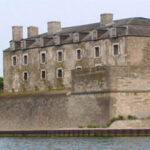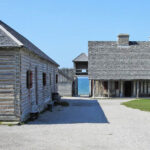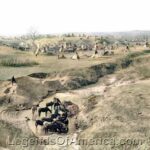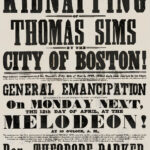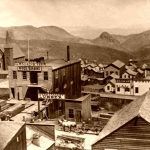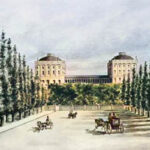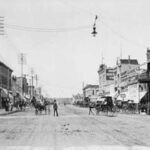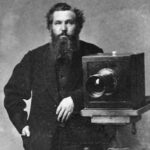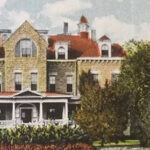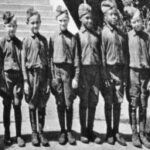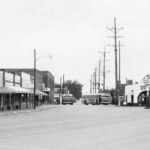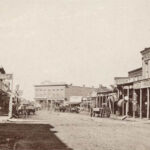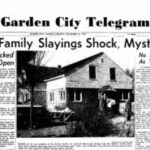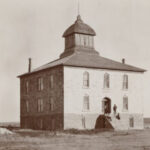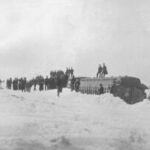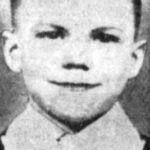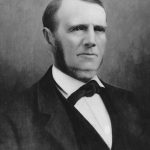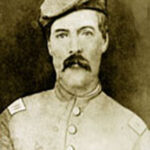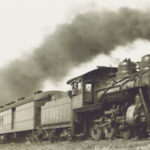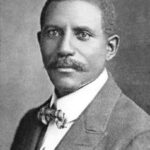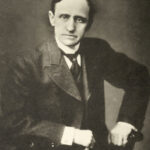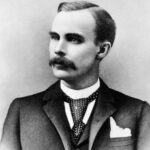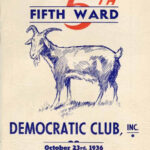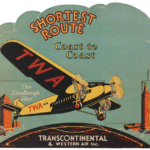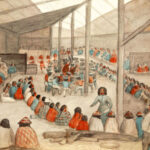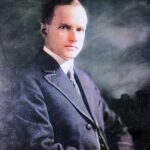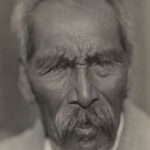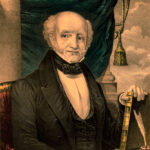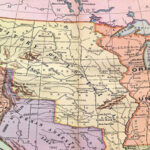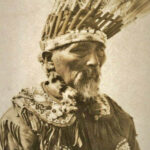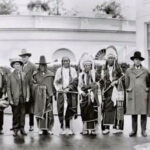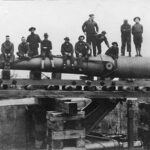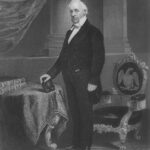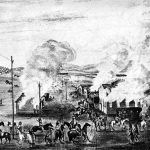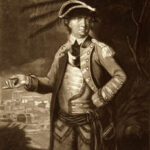Enjoy these latest additions to our website:
Kingman, Kansas – (Legends of Kansas) As early as 1872, a party from Hutchinson, Kansas, organized a town company and located a town called Sherman on what is now the townsite of Kingman, now the county seat.
Cleveland Kansas – Extinct in Kingman County – (Legends of Kansas) Cleveland, Kansas, is an extinct town in Belmont Township of Kingman County.
 April Newsletter – Dogwoods in Bloom, Riding the Pony Express, The end of the war, Getting away with murder, and more!! in this month’s newsletter.
April Newsletter – Dogwoods in Bloom, Riding the Pony Express, The end of the war, Getting away with murder, and more!! in this month’s newsletter.
Dogwood Canyon Nature Park in Missouri – (Travel Photo Blog) Near the small town of Lampe, in the Ozarks of southwestern Missouri, Dogwood Canyon Nature Park is a privately owned venture started with one intention: connect Missourians with Nature while preserving it.
John Wesley Powell – Exploring the Grand Canyon – John Wesley Powell was an American geologist, U.S. Army soldier, and explorer of the American West.
Fort Ticonderoga, New York – Fort Ticonderoga is a large 18th-century star fort built by the French at a narrows near the south end of Lake Champlain in northern New York.
Old Fort Niagara, New York – Old Fort Niagara, New York, also known as the Colonial Niagara Historic District, was a fortification built by New France to protect its interests in North America.
San Diego Presidio, California – El Presidio Real de San Diego is a historic fort in San Diego, California. Today, it commemorates the beginning of the mission effort and European settlement in California and on the Pacific Coast.
Dearborn Arsenal, Michigan – The Federal artillery arsenal was built to support American troops during the Indian Wars in the “Old Northwest Territory” and served as an Army depot for repairing guns and storing gunpowder and ammunition.
Fort Michilimackinac, Michigan – Fort Michilimackinac, Michigan, was an 18th-century French and later British fort and trading post on the Straits of Mackinac.
Burnett’s Trading Post, Michigan – Burnett’s Trading Post was once located in present-day St. Joseph, Michigan. Active from the 1770s to 1833, it was operated by William Burnett, a French fur trader and American patriot from New Jersey.
Monocacy National Battlefield, Maryland – The Battle of Monocacy, Maryland, was a Civil War conflict fought on July 9, 1864, as part of the Valley Campaigns.
Baltimore, Maryland -The Monumental City – Baltimore, Maryland, on the Patapsco River close to Chesapeake Bay is the most populous city in the state, with 585,708 people at the 2020 census.
St. Clair’s Defeat – Forgotten Disaster of the Indian Wars – When the U.S. Army faced the Western Confederacy of Native Americans during the Northwest Indian War, it suffered “the most decisive defeat in the history of the American military” and its largest defeat ever by Native Americans.
Indian War Campaigns of the United States – As settlers spread westward across the United States after 1780, conflicts increased in size, duration, and intensity between settlers and various tribes.
Fort Washington, Ohio – Fort Washington, in present-day Cincinnati, Ohio, was a fortified stockade with blockhouses built by order of General Josiah Harmar. Major John Doughy established the fort on the Ohio River’s north bank at the mouth of the Licking River in 1790.
Fort Mifflin, Philadelphia, Pennsylvania – Commissioned in 1771, Fort Mifflin was first called Fort Island Battery on the Delaware River below Philadelphia, Pennsylvania.
Chickahominy Tribe – The Chickahominy people are a tribe of the Powhatan Confederacy who formerly lived in permanent villages on the Chickahominy River in Virginia.
Piscataway-Conoy Tribe – The Piscataway/Conoy people are an Algonquian tribe related to the Lenape/Delaware, from whose ancestral stem they apparently sprang.
Famous Trials in America – Infamous trials throughout American History have created great theater for the masses. Some cases capture the public’s imagination and cause a media frenzy.
Fugitive Slave Law – The Act was one of the most controversial elements of the 1850 compromise and heightened Northern fears of a slave power conspiracy.
Shawnee, Kansas – The Gateway to Kansas – (Legends of Kansas) Starting as a Mission to area natives, Shawnee, Kansas, in northern Johnson County, is the seventh-most populous municipality in the Kansas City metropolitan area.
Cloud County Indian Conflicts – (Legends of Kansas) Robberies and outrages of various kinds occurred for several years, beginning in 1860. Horse stealing seemed to be the Indians’ peculiar weakness.
Camp Concordia – POW Camp – (Legends of Kansas) Camp Concordia was a prisoner-of-war (POW) camp in Cloud County, Kansas, operating from 1943 to 1945, about two miles north and one mile east of Concordia. The camp was used primarily for German Army prisoners captured in battles in Africa during World War II.
Getting Away With Murder – (submitted by Daniel R. Seligman) During the mining heyday of Virginia City, Nevada, Deborah Ann Phillips, a proper lady, shot and killed her drunk neighbor and got away with murder.
St. Joseph, Kansas – Extinct in Cloud County – (Legends of Kansas) St. Joseph, Kansas, is an extinct town in Cloud County. In 1873, Father Louis-Marie Mollier was sent to build a church.
Churches of Kansas – (Legends of Kansas) The first churches in what is now the State of Kansas were established while it was still an unorganized territory.
Historic Kansas Churches – Skyscrapers of the Plains – (Legends of Kansas) Today, there are numerous historic and beautiful church buildings in Kansas.
Catholic Church in Kansas – Catholic mission work in what is now the State of Kansas was started in 1827 when Father Van Quickenborn visited the Osage Indians in southern Kansas.
Presbyterian Church of Kansas – (Legends of Kansas) The Presbyterian church was the pioneer organization to begin work in what is now the State of Kansas.
Quaker Church of Kansas – (Legends of Kansas) The religious order known as Friends, more commonly called Quakers, originated in England around 1647. They were in Kansas by 1834.
Methodist Episcopal Church in Kansas – (Legends of Kansas) Methodists were among the first denominations in Kansas and, in 1906, had the strongest in numbers, with a total membership of over 121,000.
Christian Church of Kansas – (Legends of Kansas) The Christian Church, or Disciples of Christ, sometimes called Campbellites, began work in Kansas in the 1860s.
Baptists in Kansas – (Legends of Kansas) Being among the first missionaries, the Baptists were among the first to form permanent organizations in Kansas.
The History of the Sovereign States of America – (submitted by Wes Littlefield of Ammo.com) It wasn’t always territories and “united” states. These self-governing states made their own laws, minted coins, waged wars, and conducted foreign policy completely separate from any larger government.
Philadelphia, Pennsylvania – Independence Begins – The story of Philadelphia is the story of the founding of our nation’s principles and freedoms a century before the American Revolution.
Lobo, King of the Corrumpa – (submitted by Matt Doherty) The story of the North American Grey Wolf named Lobo and how his plight and capture in Corrumpa Valley of New Mexico spurred the start of the conservationist movement.

February Newsletter – Red Summer of 1919, The Belle Witch, Great Cities Across America, Women’s History Month, and much more!
People of the American Revolution – From the founding fathers to soldiers, camp followers, wives, and military leaders, there were numerous heroes of the American Revolution.
Great Cities Across America – From coast to coast, these destinations beckon with promises of adventure, discovery, and the opportunity to experience the rich diversity that defines the American experience.
Seattle, Washington – At the Center of the Klondike Gold Rush – (expanded from a previously published article), Seattle has a history of boom-and-bust cycles, rising and falling several times economically.
4 of the Best Texas Cities for History-Loving Digital Nomads – (submitted by author Sharon Redd) This article explores four hidden gems across the great state of Texas that will serve as the perfect destination for your remote working lifestyle while also satisfying your passion for history.
The Bell Witch: Tennessee’s Most Haunting Legend (submitted by author Jackie Edwards): The Bell Witch is one of the most famous legends in American folklore. It centers around the Bell family in Adams, Tennessee, during the early 19th century.
Washington, D.C. – The Capitol City – Washington, D.C., formally known as the District of Columbia, is the capital and federal district of the United States.
Dick Yeager – Bushwacking Kansas – Richard Francis Yeager, better known as Dick, was a Confederate guerilla who joined up with William Quantrill during the Civil War.
Red Summer & Civil Unrest – The summer of 1919 was branded “Red Summer” because of the bloodshed that occurred during the worst white-on-black violence in U.S. history.
Kansas City Metropolitan Area – Comprised of 14 counties that straddle the border between Missouri (9 counties) and Kansas (5 counties), it covers 8,472 square miles and has a population of more than 2.2 million people.
Gardner, Kansas – (Legends of Kansas) Gardner was founded where the Santa Fe Trail and the Oregon/California Trails were divided after sharing the same routes from Independence and Westport, Missouri.
Gardner Lake, Kansas – (Legends of Kansas) The Works Progress Administration built this 100-acre man-made lake between 1935 and 1938 to relieve the area’s drought conditions.
Olathe, Kansas – (Legends of Kansas) In the spring of 1857, Dr. John T. Barton staked two-quarter sections of land as a townsite. Carpeted with a profusion of wildflowers, the location impressed Doctor Barton as beautiful. With him was a Shawnee Indian named Dave Dougherty, who exclaimed “O-la-the,” the Indian word for beautiful, which was adopted for the name of the future city.
Winfield, Kansas – (Legends of Kansas) Winfield, Kansas, is the county seat of Cowley County. It is located on the Walnut River at its confluence with Timber Creek in south-central Kansas.
Rock, Kansas – (Legends of Kansas) Rock, Kansas, is an unincorporated village on the Walnut River in Rock Creek Township of Cowley County. The community started in 1869 when settlers began homesteading the area.
Top Tips for Winter Travel in Mountainous Regions – (Submitted by Alejandra Leyva) Sure, winter travel in mountainous regions can be fun and exciting. However, the harsh weather conditions and rugged terrains present unique challenges.
 January Newsletter – The Great Migration, Greatest Black Cowboy, Native Ordeals, Trading Posts & their Stories, and more!!
January Newsletter – The Great Migration, Greatest Black Cowboy, Native Ordeals, Trading Posts & their Stories, and more!!
Le Hunt, Kansas – Forgotten & Haunted – A ghost town today, little is left of the town beyond a few old ruins of the cement plant and an old cemetery. (Expanded from the existing article)
The Great Migration – Also known as the Great Northward Migration or the Black Migration, approximately six million African Americans moved from the American South to Northern, Midwestern, and Western states roughly from the 1910s until the 1970s.
New York City, New York – New York City, New York, located at the mouth of the Hudson River, is the most populous city in the United States, with a population of 8,804,190 in 2020.
New York City Boroughs – The boroughs were created during an 1898 consolidation when the city’s current boundaries were established. Each borough is situated in its own county.
New York City Timeline – Chronology of events of New York City, New York.
McPherson College – (Legends of Kansas) McPherson College, in McPherson, Kansas, was chartered in August 1887 by leaders of the German Baptist Brethren church.
Ladore, Kansas – Extinct in Neosho County – (Legends of Kansas) Ladore was first called Fort Roach in honor of James N. Roach, its principal founder. Today, Ladore is an extinct town in Ladore Township of southern Neosho County.
Neosho County, Kansas – (Legends of Kansas) Neosho County, Kansas, located in the southeast part of the state, was named after the Neosho River, which passes through the county.
Jacksonville, Kansas – Extinct in Neosho County –(Legends of Kansas) Jacksonville, Kansas, is an extinct town in Lincoln Township of Neosho County.
Leavenworth, Lawrence & Galveston Railroad – (Legends of Kansas) It was hoped that this railroad would help establish economic bonds with the South and link the cotton fields to the transcontinental railroad then being projected across Kansas.
Alexander Gardner – Historic American Photographer– Alexander Gardner was a Scottish photographer who immigrated to the United States in 1856 and became well known for documenting the Civil War.
Present Colleges & Universities of Kansas – (Legends of Kansas) Current list of colleges and universities in Kansas.
Washburn Univesity, Topeka, Kansas – (Legends of Kansas) Washburn University is a public university in Topeka, Kansas, that offers undergraduate and graduate programs and professional programs in law and business.
Past Colleges & Universities of Kansas – (Legends of Kansas) There are dozens of colleges and universities in Kansas that have come and gone.
Midland College and Western Theological Seminary, Atchison, Kansas – (Legends of Kansas) Midland College and Western Theological Seminary was founded in 1887 in Atchison, Kansas. The name Midland College was selected because of the college’s location midway between the Atlantic and Pacific Oceans.
State Industrial School For Girls, Beloit, Kansas – (Legends of Kansas) Beloit, Kansas was home to the girls’ reformatory, one of the longest operating schools in the country, and not without its controversies.
Academy of Mount St. Scholastica, Atchison, Kansas – (Legends of Kansas) One of the first sights to impress early visitors to Atchison, Kansas, was the imposing collection of buildings that crown its southern hill, which comprised the Academy of Mount St. Scholastica.
Kansas City University, Kansas – (Legends of Kansas) Kansas City University was a private Methodist university in Kansas City, Kansas, that was founded in 1896.
Atchison College Institute, Atchison, Kansas – (Legends of Kansas) The Atchison College Institute was founded in September 1870 by Mrs. Harriet E. Monroe, its proprietor and president. A private school, it was a cooperative enterprise of instructors.
Harriet Earhart Monroe – (Legends of Kansas) Harriet Earhart Monroe was a lecturer, educator, writer, and traveling producer of religious stage plays.
State Industrial School for Boys, Topeka, Kansas – (Legends of Kansas) The school was opened for the reception of boys on June 6, 1881. Seventy-three boys were admitted during the first year.
Boston, Kansas – Extinct in Chautauqua County – (Legends of Kansas) Boston, Kansas tried hard to become the county seat, even resorting to stealing it, but failed and would have a relatively short existence.
Elk County, Kansas – (Legends of Kansas) Elk County, Kansas, in the southeastern part of the state, was named for the Elk River, a tributary of the Verdigris River. The county seat and most populous city is Howard.
Professor Ernest Hawkins – Teaching in Fort Scott – (Legends of Kansas) The son of former slaves, Professor Ernest Hawkins, was an educator and civic leader in Fort Scott, Kansas, who was inducted into the 2001 Kansas Teachers Hall of Fame, the first person to be inducted posthumously.
Cave Springs, Kansas – Extinct in Elk County – (Legends of Kansas) Cave Springs, Kansas, south of Indian Creek, is an extinct town in Elk County founded in about 1873.
Busby, Kansas – Extinct in Elk County – (Legends of Kansas) At its peak, Busby had two general stores, two blacksmith shops, a hotel, a restaurant, a post office, a church building, and a schoolhouse.
December Newsletter – Wounded Knee, Only Law West of the Pecos, Central City, Arizona 66, and more in this month’s newsletter.
Selma, Kansas – Extinct in Anderson County – (Legends of Kansas) The town initially had two names, with the Kansas, Nebraska, and Dakota Railroad naming their station Trilby and the Missouri-Kansas-Texas Railroad named theirs Selma. Selma was surveyed and platted in the spring of 1887, and Selma became the permanent name for the town.
Republic County, Kansas – (Legends of Kansas) Before the arrival of settlers of European ancestry, the area was inhabited by Indian tribes, including the Pawnee, Ioway, and Otoe. Other nomadic Indian tribes pursued buffalo in the county, including the Arapaho, Cheyenne, Comanche, Kanza, Kiowa, Osage, and Wichita, and may have made the area their home at various times.
Seapo, Kansas – Lost in Republic County – (Legends of Kansas) Seapo, Kansas, was a rural community in Grant Township in Republic County. It was first established as Salt Marsh in 1866.
Montgomery County, Kansas – (Legends of Kansas) Montgomery County was formed from Wilson County on February 26, 1867, and named in honor of General Richard Montgomery, who was killed in action during the American Revolution.
White Rock Kansas – Lost in Republic County – (Legends of Kansas) White Rock was a small village in Republic County, Kansas. In its early days, it showed much promise, but the town is gone today.
Kansas City FBI History – The FBI has been in Kansas City, Missouri, since its earliest days. In 1920, the office was designated as one of nine “divisional headquarters” that were administratively in charge of field offices in the region.
Geary County, Kansas – (Legends of Kansas) Originally called Davis County, it is in the third tier of counties south of Nebraska and the fifth west of the Missouri River.
Junction City and Fort Kearney Railroad – (Legends of Kansas) The Junction City and Fort Kearney Railroad, a subsidiary of the Kansas Pacific Railroad, was incorporated in Kansas on June 29, 1871.
Milford Reservoir & State Park – (Legends of Kansas) Milford Lake, also known as Milford Reservoir, is the largest man-made lake in Kansas. It was built as part of the 1954 flood control act.
Early Indian Residents of Franklin County – (Legends of Kansas) By the treaty of February 23, 1867, this tribe of Indians agreed to dispose of their allotments in Kansas and to move to a new reservation in the Indian Territory (Oklahoma) within two years. By this treaty, the adult Indians were allowed to sell their own lands, and the chiefs were allowed to sell the lands of minors and incompetents.
Peabody, Kansas – (Legends of Kansas) In 1864, the first settler in the area was W.C. Coble, from North Carolina, who set up ranch headquarters about two miles east of the current city. A colony of settlers from Wisconsin was the first settlers in September 1870.
Kansas City, Kansas – (Legends of Kansas) Kansas City, Kansas, is the county seat of Wyandotte County and is located at Kaw Point, at the junction of the Kansas and Missouri Rivers in the extreme eastern part of the county. It is an inner suburb of the older and more populous Kansas City, Missouri, after which it is named. The Missouri River separates the two cities. As of the 2020 census, the city’s population was 156,607, making it one of four principal cities in the Kansas City metropolitan area.
Overland Park, Kansas – (Legends of Kansas) Once the jumping-off point for traders on the Santa Fe Trail and pioneers and gold seekers heading west on the Oregon and California Trails, pre-settlement Overland Park was a sparsely populated region with little to no roads and prairie as far as the eye could see.
Alma, Kansas – Wabaunsee County County Seat – (Legends of Kansas) Members of the Potawatomi tribe initially occupied the Alma area before being settled by the Swedes, the English, the Irish, and the Germans in 1858.
October Newsletter – Most Haunted, True Crime, Last Major Train Robbery, Native American Heritage Month, and much more in this month’s newsletter.
Tecumseh, Kansas – (Legends of Kansas) Tecumseh started when Indian trader Thomas N. Stinson built a home on a 60-acre parcel in 1852. This was before Kansas Territory was opened to settlers, but he had married a Shawnee woman, and they received a direct land grant.
Missing & Kidnapped in America – One minute they’re here, the next they’re gone. The history of infamous kidnappings in America is long and stretches back centuries. In some cases, the missing are released and recovered alive, while others are not so lucky. Other disappearances remain unsolved.
Pappan’s Ferry, Topeka, Kansas – (Legends of Kansas) Pappan’s Ferry was a major crossing of the Kansas River for travelers on the Oregon–California Trail in present-day Topeka, Kansas. The ferry was established in 1843, eleven years before Kansas was officially opened for settlement.
Bourbon County, Kansas in the Civil War – (Legends of Kansas) Article on the Civil War in Fort Scott and Bourbon County, Kansas.
Bourbon County, Kansas Border Troubles – (Legends of Kansas) After Missourians invaded the area in March 1855 to participate in the election of March 30, Bourbon County, Kansas, violence began.
Uniontown, Kansas – (Legends of Kansas) Uniontown, Kansas, one of the early settlements of Bourbon County, is situated in the Marmaton River Valley. When this community started in the 1850s, it was first called Turkey Creek.
Bronson, Kansas – (Legends of Kansas) In October 1881, the town and its post office moved south to Marion Township when the St. Louis, Fort Scott, and Wichita Railroad, a subsidiary of Missouri Pacific, arrived. This was probably the first time a U.S. post office was moved without the government’s approval.
Mapleton, Kansas – (Legends of Kansas) When a post office was established on June 15, 1857, it was named Mapleton for a grove of maple trees near the original town site.
Fort Scott, Kansas – (Legends of Kansas) Fort Scott, Kansas, the county seat of Bourbon County, is situated in the southeast part of the state, four miles from the Missouri State line. It was located on the south bank of the Marmaton River and named for General Winfield Scott. As of the 2020 census, the population was 7,552.
Garden City, Kansas – (Legends of Kansas) Garden City, Kansas, located on the Arkansas River in southwest Kansas, is the county seat of Finney County. As of the 2020 census, the population of the city was 28,151. The city is home to Garden City Community College and the Lee Richardson Zoo, the largest zoological park in western Kansas.
Holcomb, Kansas – (Legends of Kansas) This community started in 1872 when it was first called Sherlock in honor of Thomas Sherlock, Sr., a director of the Atchison, Topeka & Santa Fe Railroad.
*New Category* True Crime in America – Over the years, most crimes are quickly forgotten, but many are remembered. From the American Revolution to the Civil War, Old West days, to the Great Depression, and beyond, many famous crime stories can be found here.
Elizabeth Short – The Black Dahlia – Elizabeth Short, known posthumously as the Black Dahlia, was found murdered in the Leimert Park neighborhood of Los Angeles, California, on January 15, 1947. Her death remains one of America’s most intriguing unsolved murders.
The Beltway Snipers – The Beltway Sniper attacks, also known as the D.C. sniper attacks, were a series of coordinated shootings that occurred over three weeks in October 2002.
Bank Robbers & Thieves – Bank robbery is a federal crime in the United States, and the FBI defines the act of robbery as taking or attempting to take property by the use of force. In many cases, the offenders became part of American Folklore.
Ku Klux Klan – The Ku Klux Klan, commonly shortened to the KKK or the Klan, is the name of several historical and current American white supremacist, far-right terrorist organizations and hate groups.
Serial Killers of America – A serial killer is typically a person who kills three or more people, with the murders taking place over more than a month and including a significant period between them. The Federal Bureau of Investigation (FBI) defines serial murder as “a series of two or more murders, committed as separate events, usually, but not always, by one offender acting alone.
United Airlines Highjacked in 1972 – On April 7, 1972, Richard Floyd McCoy, Jr. hijacked a United Airlines flight and parachuted from the plane over Utah with ransom money. This was one of the best-known D.B. Cooper copycat hijackings, but this time, FBI agents would track down the hijacker.
Clutter Family Murders – In Cold Blood – (Legends of Kansas) In 1959, the brutal murders of four members of the Clutter family in the small farming community of Holcomb, Kansas, shocked the nation when the story hit the news. Murder of this magnitude just didn’t happen to farm families in the heartland of America.
Three of the Most Celebrated Gardens in American History – (submitted by Jackie Edwards) Tracing roots back to the 1600s, this affection for flora continues to bloom through our history, synergizing local practices and artistic inspirations.
Point of Rocks Finney County Kansas – (Legends of Kansas) Finney County Point of Rocks is one of at least four similarly named sites along the Santa Fe Trail that aided travelers in their navigation of the road. The trail passed to the immediate south of this formation and became the foundation for modern-day Mansfield Road.
Kalvesta, Kansas – Extinct in Finney County – (Legends of Kansas) Kalvesta, Kansas, is an unincorporated community in Finney County. It is also an extinct town, as it no longer has a post office. Its name was derived from the Greek word kalos, meaning “beautiful,” and Vesta, the Roman goddess of the hearth and home.
Finney County, Kansas – (Legends of Kansas) Finney County, Kansas, in the southwest part of the state, is in the Arkansas River Lowlands. It was named for David Finney, the Lieutenant Governor of Kansas from 1881 to 1885.
Pierceville, Kansas – Tiny Town in Finney County – (Legends of Kansas) Cattlemen created Pierceville in the early spring of 1872 when the Barton Brothers drove 3,000 head of cattle up from southern Texas over the Great Western Trail.
Garfield County, Kansas – Lost in County Seat War – (Legends of Kansas) Garfield County, Kansas, located in the southwest portion of the state, was created on March 5, 1887, but only existed until 1892 after court battles.
 September Newsletter – Adventure from Alamosa, Kansas Blizzard of 1886, Monster Crash at Crush, Haunted St. Augustine, and More! in this month’s Newsletter.
September Newsletter – Adventure from Alamosa, Kansas Blizzard of 1886, Monster Crash at Crush, Haunted St. Augustine, and More! in this month’s Newsletter.
Adventure from Alamosa – Dunes to Ruins (Travel Blog) – Looking for a “base” to explore parts of Southern Colorado, we landed in Alamosa for a fun few days of exploring the Great National Sand Dunes and the historic mining district of Creede Colorado.
Kansas Blizzard of 1886 – (Legends of Kansas) The blizzard of December 1885 and January 1886 was probably the most destructive to life and property of any storm that ever swept over Kansas.
Jetmore, Kansas – (Legends of Kansas) Jetmore, Kansas, the county seat of Hodgeman County, was initially called Buckner when it was laid out in 1879.
Hodgeman County, Kansas – (Legends of Kansas) Hodgeman County, Kansas, in the southwest part of the state, was established and named for Amos Hodgman, a Captain of the 7th Regiment Kansas Volunteer Cavalry and noted buffalo hunter, in February 1887.
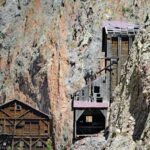 Creede Colorado – Silver & Gold on the Rio Grande – For an adventure into old-west mining, scenic views, historic ruins, and more, Creede Colorado and Bachelor Loop will not disappoint.
Creede Colorado – Silver & Gold on the Rio Grande – For an adventure into old-west mining, scenic views, historic ruins, and more, Creede Colorado and Bachelor Loop will not disappoint.
Weir, Kansas – (Legends of Kansas) – A former coal-mining town, Weir was founded and laid out in 1872.
Revitalizing Abandoned Coal Mining Towns: Exploring Opportunities for Repurposing and Sustainability – (submitted by Jackie Edwards) Throughout the country, sustainable and exciting initiatives are underway to resculpt these old mining communities.
The Legend of Daisy Town: A Journey Through Time in the Smoky Mountains – (submitted by Ck Harrington) Daisy Town’s story is intricately woven into the tapestry of American history, reflecting the birth of tourism and the inception of the National Parks.
Greenlease Kidnapping in Kansas City, Missouri – In 1953, six-year-old Robert Cosgrove Greenlease Jr. was kidnapped from Kansas City, Missouri, murdered, and ransomed for $600,000.
Tips on Traveling with Pets Across the Country – (submitted by Alejandra Leyva) But before you strap in Fido or whisk Whiskers away on a grand journey, traversing the nation with your beloved animal sidekick requires a fusion of preparation, patience, and a pinch of adventure.
Missouri in the Civil War – During the Civil War, Missouri was a hotly contested border state populated by Union and Confederate sympathizers.
 August Newsletter – The Potatoe King, the Pennsy, the Pima, and unsung lawmen. That and more in this month’s newsletter.
August Newsletter – The Potatoe King, the Pennsy, the Pima, and unsung lawmen. That and more in this month’s newsletter.
Woolworth Stores Across the World – (from our Businesses to the Wayside) The Woolworth Company, the pioneer of “five-and-dime” stores worldwide, started in 1879 and, for more than 100 years, would remain a mainstay for value shoppers and diners in thousands of buildings.
John C. McCoy – Founder of Westport, Missouri – John Calvin McCoy, Sr. founded Westport, Missouri, where he settled in 1830. He was also one of the founders of the Town of Kansas, Missouri, in 1838, which later became Kansas City, Missouri.
Padouca Indians – Accounts of early exploration in the West show that the Padouca Indians, under their various similar names, occupied the central plains.
The Great Pennsylvania Railroad System – The Pennsylvania Railroad Company, also known as the “Pennsy,” was an American Class I railroad established in 1846 and headquartered in Philadelphia, Pennsylvania.
Sylvan Grove, Kansas – (Legends of Kansas) Sylvan Grove, in Lincoln County, is located in north-central Kansas, designated as “Post Rock Country.”
Allison J. Pliley – Brave Kansas Soldier – (Legends of Kansas) One of Kansas‘ greatest soldiers, Captain Allison J. Pliley, was famous as a scout and cavalry officer in the frontier days.
Camp Pliley in Lincoln County – (Legends of Kansas) Camp Pliley was one of four military camps in Lincoln County, Kansas, that were established to deal with Indian raids in which several settlers were killed.
Silkville, Kansas – Failed Utopia – (Legends of Kansas) Silkville, Kansas, located in Franklin County, was a collection of private buildings owned by Frenchman Ernest de Boissiere, whose farm consisted of 3,600 acres under the management of Charles Sears.
Minneola, Kansas – A Ghost in Franklin County – (Legends of Kansas) Minneola, Kansas, in Franklin County, started as St. Bernard in 1855. The town no longer exists today.
Canadian Pacific and Kansas City Railroad – The Kansas City Southern Railroad started as the Kansas City Suburban Belt Railway, founded by Arthur Stilwell and Edward L. Martin in 1887.
Kickapoo, Kansas – Extinct in Leavenworth County – (Legends of Kansas) Kickapoo, Kansas, one of the oldest towns in Leavenworth County, was first called Kickapoo City. The town is extinct today.
Bonner Springs, Kansas – (Legends of Kansas) The area’s early settlers were the Kanza Indians, who had lived here because of the mineral springs and abundant fish and game.
Junius George Groves – Potato King of the World – (Legends of Kansas) Junius George Groves was an African American farmer and entrepreneur remembered as one of the wealthiest black Americans of the 19th and early 20th centuries.
Edwardsville, Kansas – (Legends of Kansas) A Delaware Chief named Half-Moon was the original owner of the land where downtown Edwardsville now stands.
Turner, Kansas – (Legends of Kansas) Turner, Kansas, now a neighborhood within Kansas City, Kansas, was formerly an unincorporated community of Wyandotte County.
Armstrong, Kansas – (Legends of Kansas) Armstrong, Kansas, once an independent city in Wyandotte County, is part of Kansas City, Kansas, today.
Give Yourself A Break: How to Travel On a Budget With Kids – (By Daniel Sherwin – DadSolo.com) Traveling with young children can be a daunting task, especially for parents who are on a tight budget. However, with the right preparation, traveling can be a fun and rewarding experience for the whole family.
 June Newsletter – The Beginnings of Kansas City, Cliff Dwellers, A ghostly ghost town, Wicked Dodge, and Legends Turns 20! In this month’s newsletter.
June Newsletter – The Beginnings of Kansas City, Cliff Dwellers, A ghostly ghost town, Wicked Dodge, and Legends Turns 20! In this month’s newsletter.
White Church, Kansas – (Legends of Kansas) White Church, Kansas, located nearly in the center of Wyandotte County, was one of the earliest settlements in the area. An extinct town today, it was located about ten miles west of the town of Wyandotte.
Rosedale, Kansas – From Municipality to Neighborhood – (Legends of Kansas) Rosedale, Kansas, was platted in Wyandotte County in 1872 by James G. Brown. However, the building of the town did not begin until 1875, when the roller mills were established.
Amourdale, Kansas – Once a City, Now a Neighborhood – (Legends of Kansas) Armourdale, Kansas, once an independent municipality, is a neighborhood of Kansas City, Kansas, today.
Six-Gun City, Jefferson, New Hampshire – Six-Gun City in Jefferson, New Hampshire, was a Frontier Western-style amusement park that thrilled young cowboys and cowgirls for almost 60 years
Robert A. Long – Lumber Baron – Robert Alexander Long was a lumber baron, developer, investor, newspaper owner, and philanthropist. He lived most of his life in Kansas City, Missouri.
Longview Farm, Lees Summit, Missouri – Longview Farm in Lee’s Summit, Missouri, was built by millionaire lumber baron Robert Alexander Long. It is listed on the National Historic Register.
William M. Chick – Kansas City Founder & Pioneer – William M. Chick was a Kansas City, Missouri pioneer, founder, merchant, and first postmaster.
Historic People of Kansas City, Missouri – Every city and every place leaves behind numerous people who made it what it is today. Here are a few that shaped Kansas City, Missouri.
Robert Gillham – Founder of Kansas City’s Cable Railway – Robert Gillham founded Kansas City, Missouri’s Cable Railway System. He was one of the pioneers in cable railway construction in the nation.
Colonel Kersey Coates – Kansas City Businessman – Colonel Kersey Coates was a Kansas City, Missouri businessman who developed Quality Hill, founded the Kansas City Board of Trade, and was among those who attracted the Hannibal & St. Joseph Railroad to the city.
Pendergast Era of Kansas City, Missouri – Between 1890 and 1940, the Pendergast Era was ruled by Democratic big city bosses James and Tom Pendergast.
Camp Jackson Affair, St. Louis, Missouri – The Camp Jackson Affair, also known as the Camp Jackson Massacre, occurred on May 10, 1861, during the Civil War.
Wayne City Landing, Missouri – Wayne City Landing, often called the Upper Independence Landing, was a jumping-off point for traders and pioneers heading westward on the trails.
Emery, Bird, Thayer & Company in Kansas City, Missouri – Emery, Bird, Thayer & Company was a department store in Downtown Kansas City, Missouri, that traced its history nearly to the city’s origins as Westport Landing.
Camp Union, Kansas City, Missouri – Camp Union, also known as Fort Union, in Kansas City, Missouri, was established after the Civil War began on April 12, 1861.
Lost Orpheum Theatres in Kansas City – In Kansas City, Missouri’s history, there were two Orpheum Theatres that provided a higher class of vaudeville entertainment.
City of Kansas, Missouri – Before Kansas City – Old Kansas Town, the predecessor of Kansas City, started in 1838 when John McCoy and 13 other men laid out a new town along the Missouri River.
Kansas City, Missouri Timeline – Chronological timeline of Kansas City, Missouri.
Businesses to the Wayside – Businesses fail daily for various reasons. Many, thought to have been American staples, have also failed.
Trans World Airlines – A Long Road to Failure – Trans World Airlines, Inc. (TWA) was a former American airline that maintained extensive routes in the United States, Europe, the Caribbean, and the Middle East. It operated from 1930 until 2001, when it was absorbed by American Airlines.
May Newsletter – Memorial Day and Who it Honors, Indian Removal Act of 1830, Landmarks on the Oregon Trail, America’s Mother Road, and more!! In this month’s newsletter.
Buckroe Beach in Hampton, Virginia – Buckroe Beach, a neighborhood of Hampton, Virginia, is north of Fort Monroe on the Chesapeake Bay. The amusement park that was once here is gone today.
Missouri Pacific Railroad – The Missouri Pacific Railroad, also known as the MoPac, was one of the first railroads in the United States west of the Mississippi River.
Potlach Ceremony of Native Americans – The ceremony celebrated a change of rank or status with dancing, feasting, and gifts. Those of the Northwest Coast associated prestige with wealth, and the potlatcher gained prestige according to how liberally he gave.
Tlingit Tribe of the Northwest – The Tlingit tribe once controlled all the land that extends more than 500 miles from Yakutat Bay to the British Columbia border south of present-day Ketchikan, Alaska. Their name for themselves is Lingít, meaning “people of the tides.”
John Margolies – Roadside Photographer – John Margolies was a fantastic photographer, author, and architectural critic who captured thousands of photographs of buildings and roadside attractions between 1969 and 2008.
Coral Court Motel – Vanished From St. Louis, Missouri – The Coral Court Motel in Marlborough, Missouri, a suburb of St. Louis, was an exceptional example of Art Deco and streamlined modern architectural styles of the 1930s and 1940s on Route 66.
April Newsletter – What happened to Dairy Boy?, Black Sunday, Death Valley, an understated President, and much more in this month’s newsletter.
Easy Travel Organization Tips You Will Love – Whether a seasoned traveler or going for your first-ever adventure, getting organized is always a pain in the neck. Use these tips for easy travel.
Oklahoma Santa Fe Trail Sites – The smallest portion of the Santa Fe Trail was in Oklahoma. Of the two major trail branches, only the Cimarron Route crossed into the state through the western portion of the Oklahoma panhandle in modern Cimarron County.
Bidwell-Bartleson Party – Blazing the California Trail – The Bidwell-Bartleson Party, led by Captain John Bartleson and John Bidwell, became the first American emigrants to attempt a wagon crossing from Missouri to California.
Calvin Coolidge – 30th President – The United States’ 30th President was a man of few words, but bold actions.
Rockville – Attacked by Confederates – (Legends of Kansas) Among the first settlers in this part of the county, if not the first, was Josiah Allen, who came here in about 1843.
New Lancaster – Extinct in Miami County – (Legends of Kansas) The first school taught in Miami County was taught in this area in 1858 by Mrs. Cyrus Shaw. A post office was established in the settlement on February 17, 1859.
Dairy Boy Drive-Ins in Oklahoma – The Dairy Boy Drive-In chain was founded in 1957 by businessmen Harry Atlee and Leonard Hansen, who owned the Hansen-Atlee Dairy in Oklahoma City.
Mission San Juan Capistrano, California – The birthplace of Orange County, it was founded over 240 years ago by Spanish colonists as the seventh of 21 Catholic missions in California.
Miwok Indians of Northern California – The Miwok people are members of four linguistically related Native American groups indigenous to Northern California.
Maidu Indians of Northern California – The Maidu are a Native American people of northern California. Known as the Maiduan, they have inhabited the land for thousands of years.
Acjachemem People of Southern California – The Acjachemem people historically lived in present-day Orange, northern San Diego, southern Los Angeles, and western Riverside Counties of California.
Martin Van Buren – Eighth President– Martin Van Buren was an attorney, statesman, and eighth President of the United States after serving as Andrew Jackson’s Secretary of State and Vice President.
Great Lakes of North America – These five lakes, together with the St. Lawrence River, contain 20% of the world’s fresh water and form the world’s most extensive surface freshwater system.
March Newsletter – A Nation was born here, Battlefields and Rockets, Charles Goodnight, It’s Women’s History Month, and more! in this month’s newsletter.
Development of the Great West – At the close of the Civil War, the nation began to expand westward, railroads were built, and new states were admitted to the Union. (Historic text from 1921)
The Admission of New States – During Westward Expansion, several new states sought Federal Recognition, including Colorado, Nebraska, Oklahoma, New Mexico, Arizona, Utah, and others. (Historic text from 1921)
Mining and Manufacturing in the West – Indeed, the minerals rather than the land attracted the pioneers who opened the West. (Historic text from 1921)
Evolution of Grazing and Agriculture – The effect of irrigation, wherever introduced, was amazing. Stretches of sand and sagebrush gave way to fertile fields bearing wheat, corn, fruits, vegetables, and grass crops. (Historic text from 1921)
The Railways As Trail Blazers – A decade before the Civil War, the importance of rail connection between the East and the Pacific Coast had been recognized. (Historic text from 1921)
Indian Tribes of California – It has been estimated that when Europeans first came to California, the native population was probably close to 300,000, about 13% of indigenous peoples in North America.
Pit River Tribe of California – The Pit River Indian tribe traditionally occupied lands along the Pit River in the far northeastern part of California, which included Mount Shasta and Lassen Peak to the Warner Range.
A Nation Was Born Here (Legends Travel Blog) – Our arrival in Washington On the Brazos coincided with the annual Texas Independence Celebration. And we explored Navasota, Train Town USA.
Battlefields and Rockets at Brownsville (Legends Travel Blog) For our Winter 2023 adventure, we came back to the Lone Star State, visited the southernmost fort, and found a Starbase… far out!.
Cowlitz Tribe of Washington – The Cowlitz tribe, who spoke their own language, belongs to the Salishan family of languages among Northwest Coast indigenous peoples in Washington.
Chimariko Tribe of Northern California – The Chimariko people are a small tribe comprising the Chimarikan family, who formerly lived on the Trinity River near the mouth of New River in Northern California.
Frank Hamer – Captain Frank Hamer was a Texas Ranger and Lawman who led the posse that tracked down and killed notorious outlaws Bonnie Parker and Clyde Barrow in 1934
Navasota, Texas – Train Town USA – Navasota, Texas, located on a bend of the Navasota River in southeastern Grimes County, started in 1822 when Francis Holland bought land there.
Washington-on-the-Brazos, Texas – Declaring Independence – Washington-on-the-Brazos, Texas, was the site of the 1936 Convention and the signing of the Texas Declaration of Independence.
Kansas Railroad Timeline – (Legends of Kansas) The rapid growth of railroads in Kansas after the Civil War was a response to an existing need and an attempt to meet the challenge of future development.
Miami County, Kansas – (Legends of Kansas) Miami County, Kansas, located in the east-central part of the state, is part of the Kansas City metropolitan area.
Stanley, Kansas – Extinct but Still Here – (Legends of Kansas) Stanley, Kansas, eight miles southeast of Olathe in the eastern part of Johnson County, was annexed to Overland Park in 1985.
Kansas Becomes Part of the United States – (Legends of Kansas) A summary of time periods leading to Kansas becoming part of the United States.
Period of Political Contests – (Legends of Kansas) The Missourians had given up hope of conquering Kansas by force. The contest then became a political struggle between pro-slavery & Free-State supporters.
The Period of Violence – (Legends of Kansas) Missourians prepared to invade Kansas, destroy Lawrence, & drive the Free-State people out or force them to recognize the pro-slavery Government.
Rival Governments in Kansas – (Legends of Kansas) Two governments were established in Kansas Territory – one for pro-slavery advocates and the other for those fighting for the Free-State cause.
The First Territorial Government of Kansas – (Legends of Kansas) When a territory is organized, it must be provided with a government. However, Kansas residents were immediately at odds regarding government intent.
Kansas Organized as a Territory – (Legends of Kansas) White settlers did not come to Kansas in peace and quiet; the first dozen years following 1854 were filled with hatred, struggle, and bloodshed.
Exploration of Kansas by the United States – (Legends of Kansas) Several expeditions were sent westward to explore new lands after the Louisiana Purchase.
Black Bob Reservation in Johnson County – (Legends of Kansas) Chief Black Bob and his Shawnee band of Cape Girardeau, Missouri, lived on land controlled by Spain in eastern Missouri before moving to Kansas.
The Beginning of Kansas History – (Legends of Kansas) The Spanish were the first to explore much of the United States, including Kansas.
Make History Come Alive With These Online Tools and Resources – (By Daniel Sherwin – DadSolo.com) From interactive maps to digital archives, these resources allow you to supplement your lessons with engaging activities that keep your students interested.
February Newsletter – Buffalo Soldiers, Gullah/Geechee Cultural Heritage Corridor, Presidents, heroes, traitor, and Hey, Your Truck’s on Fire! in this month’s Newsletter.
Fort Mott, New Jersey – Unusual for U.S. coast defense forts built between 1895 and 1935, Fort Mott was designed to resist a land attack.
The University of Kansas, Lawrence – (Legends of Kansas) The university, often referred to as “KU,” formally opened its doors to students in September 1866, but its history began in 1855. At that time, the first legislature made a provision for a Kansas university, with buildings to be erected when Congress or benefactors would give money for their construction.
Education in Kansas – (Legends of Kansas) The first schools in Kansas were the mission schools for the Indians. Numerous schools were added in the next decades, including colleges.
Industries of Kansas – (Legends of Kansas) Several industries thrived in Kansas in its early years including farming, livestock, coal mining, oil and gas, and manufacturing.
Coming of the Settlers to Kansas – (Legends of Kansas) When Kansas Territory was organized, little was known, but because the North and the South wanted it, knowledge of Kansas spread rapidly
Kansas As a Pathway – (Legends of Kansas) Many roads and trails passed through Kansas during Westward Expansion.
Pioneer Life in Kansas – (Legends of Kansas) The seven territorial years had brought freedom to Kansas. However, the struggle left the pioneers little room for improvement.
Kansas After the Civil War – (Legends of Kansas) The earlier years in Kansas were but a time of preparation, and with the war’s end, the people were at last free to turn their attention to farming or other occupations.
Kansas as an Indian Country – (Legends of Kansas) During the years when the white men were traveling back and forth across Kansas, they were not making settlements here. The country remained in the undisputed possession of the Indians.
James Buchanan – 15th President – James Buchanan was a lawyer, diplomat, and the 15th President of the United States, who served immediately before the Civil War. He remains the only president to be elected from Pennsylvania and is a lifelong bachelor.
Chinese Immigration to the United States – In the 1850s, Chinese workers first migrated to the United States to work in the gold mines and take agricultural jobs and factory work. It would begin a century-long struggle for immigration rights.
Purchase of Alaska, 1867 – The purchase of Alaska in 1867 marked the end of Russian efforts to expand trade and settlements to the Pacific coast of North America.
Union Victory of the Civil War – The Union victory in the Civil War demonstrated the strength of the United States Government.
Continental Congress, 1774–1781 – The Continental Congress was the governing body by which the American colonial governments coordinated their resistance to British rule during the first two years of the American Revolution.
Fort Hancock, New Jersey – Fort Hancock is a former United States Army fort at Sandy Hook, New Jersey. The coastal artillery base defended the Atlantic coast and the entrance to New York Harbor, with its first gun batteries operational in 1896.
Samuel de Champlain – Explorer & Diplomat – Samuel de Champlain was an important figure in Canadian history who created the first accurate coastal map during his explorations and founded various colonial settlements.
War on the Oregon & California Trails – Once-friendly Western tribes watched with mounting anger as emigrants helped themselves, often wastefully, to their game, grass, water, and wood.
Ship Wrecks of Cape Cod, Massachusetts – With good cause, sailors steered clear of the Cape Cod coast, for over the years, thousands of vessels have been destroyed on its bars and rocks.
Cape Cod, Massachusetts & National Seashore – The name Cape Cod, coined in 1602 by Bartholomew Gosnold, is the ninth oldest English place name in the United States. Cape Cod National Seashore has long inspired wonder among those who value nature.
Nauset Tribe of Cape Cod, Massachusetts – The Nauset people, sometimes referred to as the Cape Cod Indians, were a Native American tribe that lived in Cape Cod, Massachusetts.
Benedict Arnold -Traitor of the American Revolution – Benedict Arnold was an American military officer in the American Revolution. He fought with distinction for the Continental Army before turning traitor.
William Henry Harrison – 9th President – William Henry Harrison was an American military officer and politician who served as the ninth President of the United States.
World War II – World War II was the largest and most violent armed conflict in the history of mankind, involving more than 30 countries. America was reluctant to get involved.
Outbreak of the American Revolution – The American Revolution began because, by 1763, the English-speaking colonies had matured, and their interests were different from the Mother Country.
Revolutionary War Campaigns – While there were over 230 skirmishes and battles fought during the American Revolution, these were the primary war campaigns.
The Continental Army – The Continental Army represented the Thirteen Colonies in the American Revolution. The army was created to coordinate the military efforts of the colonies in the war against the British, who sought to maintain control over the American colonies.
The United States – A New Nation – The Declaration of Independence on July 4, 1776, established a new nation and transformed a limited uprising into a revolution that wasn’t easy to pay for.
John Quincy Adams – Sixth President of the United States – Son of our second president John Adams, John Quincy Adams was an American statesman, diplomat, lawyer, and diarist who served as the sixth president of the United States from 1825 to 1829.
James Monroe – Fifth President of the United States – The fifth president of the United States, James Monroe, was a statesman, lawyer, and diplomat who served as president from 1817 to 1825. He was the last president who was a Founding Father and, like four of his predecessors in office, was a native of Virginia.
General Anthony Wayne – Brave Officer of the American Revolution – Anthony Wayne was an American soldier, officer, politician, and one of the Founding Fathers of the United States.
James Madison – 4th President of the United States – James Madison Jr. was an American statesman, diplomat, and Founding Father. He served as the fourth President of the United States from 1809 to 1817. (Historic text from Eminent Americans, Vol II, 1890)
January 2023 Newsletter – American Hero, Dinner with Sam Adams, Taos Revolt, The Lady & the Mule, and much more! in this month’s Newsletter.
To see what else you might have missed, check out our archive of newsletters here.


